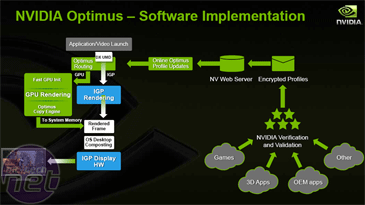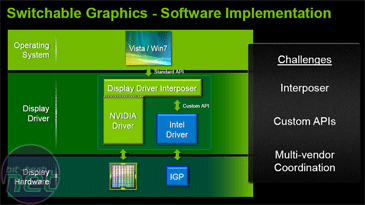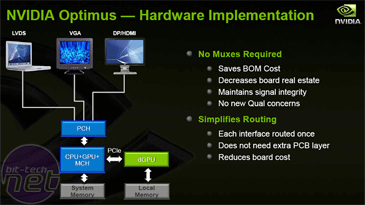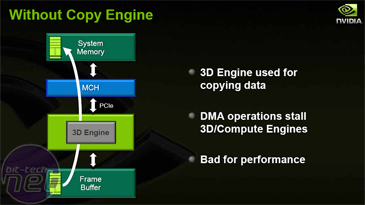
Prime technology for your notebook
From a technical perspective, what's really fascinating is that Nvidia has managed to execute this considering its current fractious relationship with Intel, not to mention that Nvidia managed it ahead of AMD, which has had access to CPU and GPU technology ever since the ATI buyout. Its PowerPlay technology was demonstrated (on paper) to us at least two years ago, but unfortunately given the dire financial situation at that time and since, we suspect it was one of the many projects dropped.By working with Intel's own GPU hardware - it sends it a display output from its own GPU - Nvidia's technology also reduces the cost of using Optimus (both in product development and manufacture), which is always attractive to hardware vendors.
It works by using a custom API that addresses the Intel GPU driver, connecting this and its own GPU to an interposer: an 'additional chip' that asynchronously copies the frame buffer between main memory (in the area dedicated to the IGP) and the local frame buffer on the discreet graphics hardware, to keep them in sync. This way, as the display surface alone is transferred from IGP to GPU over the PCI-Express bus, the image can switch immediately without the screen going blank or waiting to reload the graphics interface.
We've no further details of this, the 'Optimus Copy Engine', but it does intrigue us greatly - in terms of what hardware Nvidia takes to do this and what is the performance hit given the extra traffic to system memory (PCI-Express x16 2.0 has plenty of bandwidth to spare, though).
Given the backward compatibility with older GeForce products, we strongly doubt it's a recent addition to GPU hardware on Nvidia's part. Its original Hybrid Technology that was added in its 9000 series desktop GPUs is only designed to directly address the GPU into waking/sleep states. Asus won't let us take apart their demo laptop though, which is a shame, but not unexpected considering what I did to the £1,000 Asus MARS graphics cards, as we left them unable to transform back to their original, working state....
Nvidia's technology is currently limited to Intel systems only, though this isn't a big deal because it's most of the market anyway - particularly for notebooks that use performance CPUs, which are usually paired with additional graphics hardware. Optimus isn't limited to being paired with high-end hardware though; as the drivers detect what IGP the Nvidia hardware is paired with - from G3150 in the latest Atom 'Pineview' CPUs to its fastest GMA HD GPUs - and decides which provides the most optimal use of its time.
For example, GMA HD/4500MHD will decode HD video just fine, but the Nvidia hardware will power up in games and video transcoding, however in the upcoming Ion 2 platform for Atom 'Pineview' CPUs, the graphics will take over the limited G3150 in all scenarios bar entirely CPU driven software. It's all still customisable from the control panel though.
Overall, it's an exciting idea, and we'll be looking at some Optimus laptops soon.

MSI MPG Velox 100R Chassis Review
October 14 2021 | 15:04














Want to comment? Please log in.